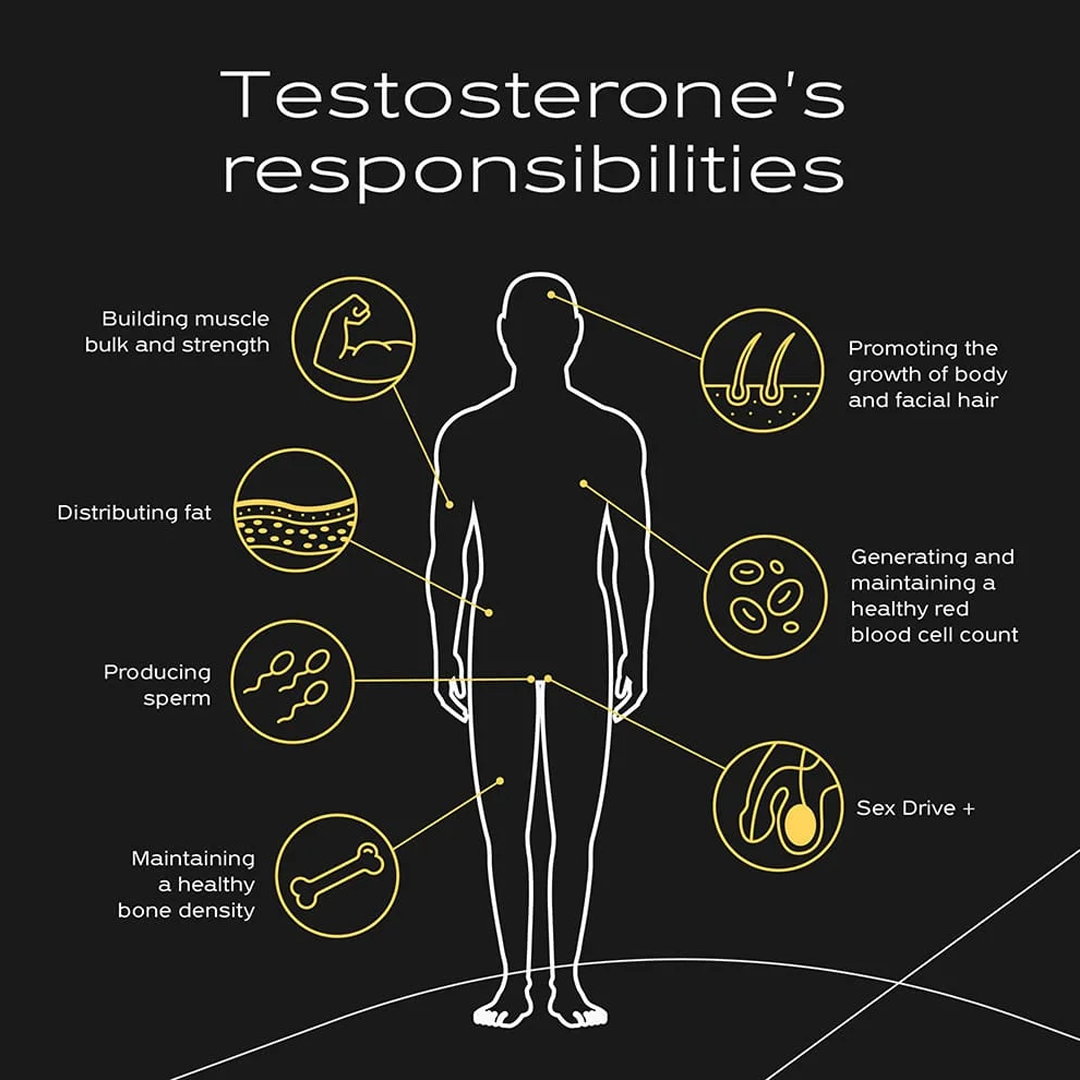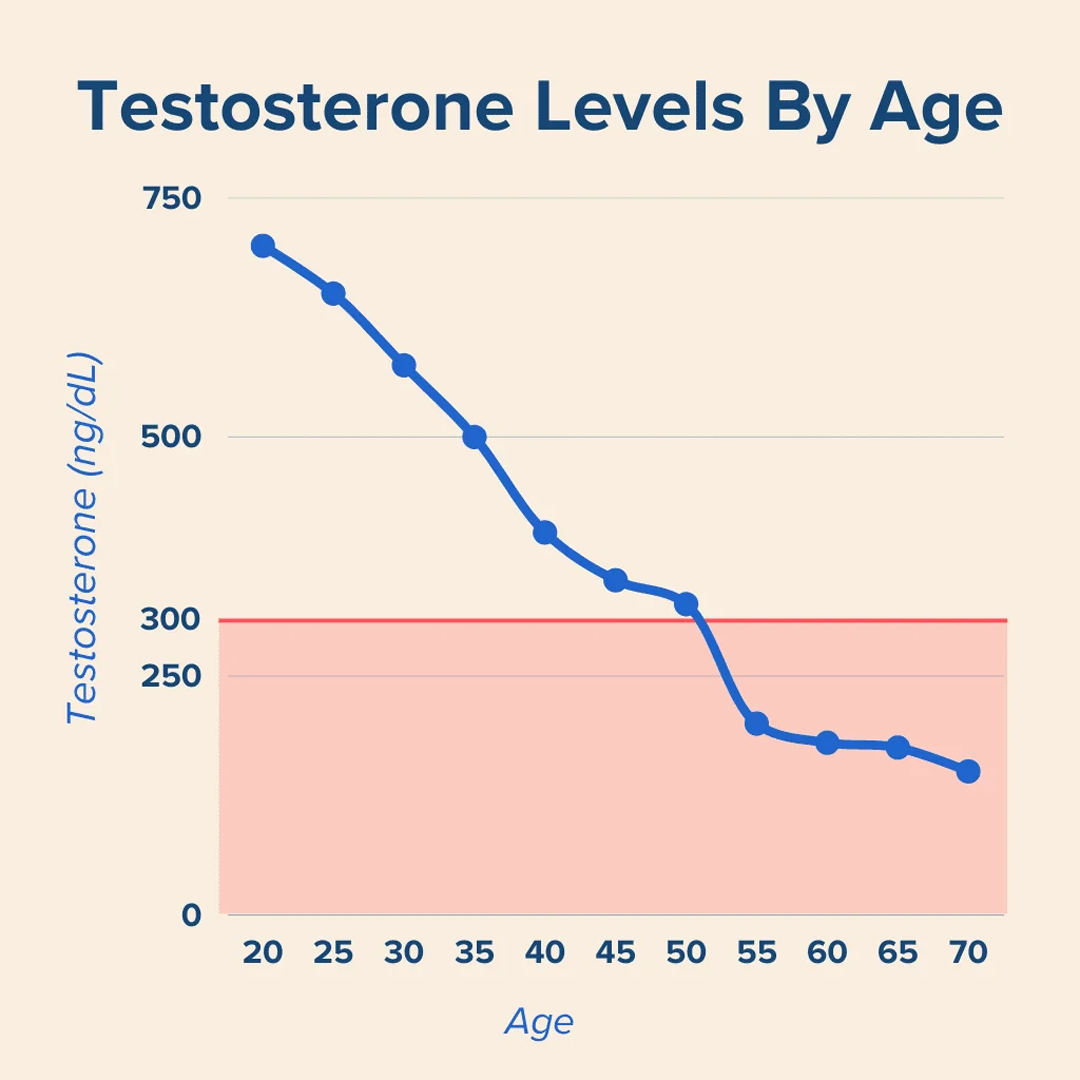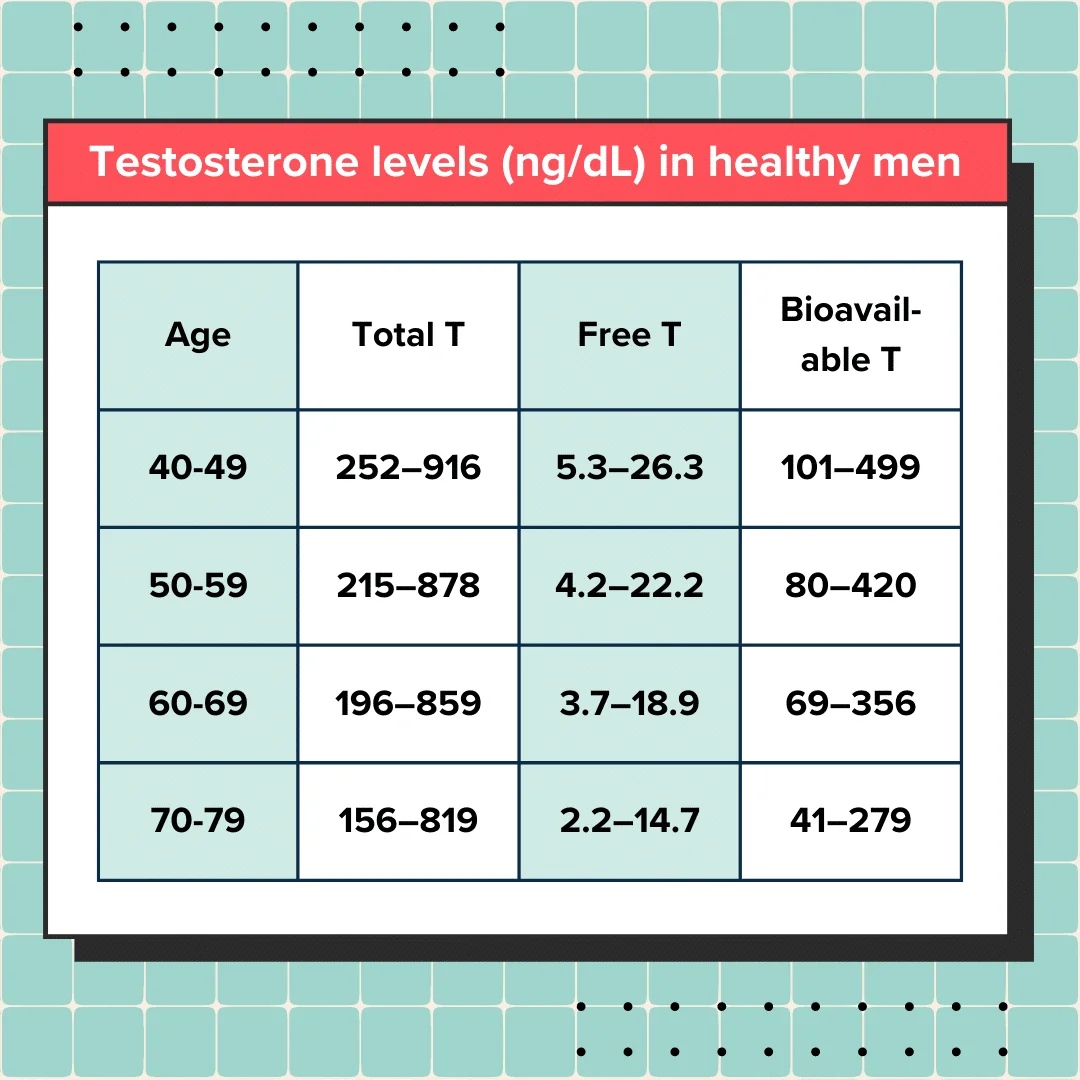What are normal testosterone levels by age?

fizkes // Shutterstock
What are normal testosterone levels by age?
An older photographer mentors a younger one.
Testosterone is an important hormone. It helps men develop during puberty, and as they age, it plays a critical role in helping control fat levels, cholesterol, and glucose levels. Testosterone production peaks in your teen years and remains high until your mid-30s, when your testosterone levels start to decline, at the rate of one to two percent per year.
But determining normal testosterone levels by age? That’s a little more complicated.
Hone Health reports, a combination of age, genetics, and pre-existing medical conditions determines your testosterone levels. A guy in his 20s with healthy genes and no chronic ailments will have a higher testosterone level than a 55-year-old with ongoing medical issues.
30-second Takeaway
- Testosterone levels peak in the teen years. When men are in their mid-30s, testosterone levels begin to decline.
- A healthy testosterone level depends on your age, genetics, and lifestyle.
- If you are experiencing symptoms of low testosterone, you should test your T levels and consult a physician.
Testosterone Levels By Age
“To determine what’s a good T level for your age, you also need to look at the clinical picture,” says Danielle McDevitt, M.D., a physician who specializes in hormones.
“By that, I mean how you, the patient, are feeling. Younger patients who have a sedentary lifestyle, who aren’t athletic and out running marathons; they don’t need a high level of testosterone. But if you’re 50 and doing triathlons, you’ll need higher levels.”
![]()

Hone Health
Why You Need Healthy Testosterone Levels For Your Age
Infographic about testosterone’s responsibilities to the body.
Testosterone is a hormone that’s crucial for men’s health. Produced by your testicles, this androgen plays an essential role in your sex drive, sperm production, muscle growth, bone growth, hair growth, voice deepening, and red blood cell production. Testosterone also “helps control our lipids, cholesterol, and glucose,” says McDevitt.
“Testosterone also helps protect your bones from osteoporosis; it helps keep bones strong and prevents loss of bone density. Lastly, it helps protect the brain against dementia and memory loss. If your testosterone is within a good range, you’re more sharp; you’re thinking more clearly.”
As you age, hormone levels decline. You may become pre-diabetic, or see your cholesterol levels rise, says McDevitt. “We tend to blame this on poor diet and lifestyle choices—which can definitely be a large factor.”
But if you’re pretty healthy, you adhere to a plant-based diet with a little protein mixed in, and you’re still seeing medical conditions like pre-diabetes creep up or your thinking isn’t as sharp, doctors often look at where your testosterone levels are.
“I see patients often who say they’re having a hard time with emails and texts, unable to shoot off answers to simple questions with ease. That’s when we start to check your hormone levels,” McDevitt says.
What Are Normal Testosterone Levels By Age in Men?
Testosterone is measured in nanograms per deciliter (ng/dL). At its peak, during your adolescent years, a normal range for your testosterone is anywhere between 300 and 1,200 ng/dL. When you’re entering your mid-30s, you’ll start to see it declining by at least one percent per year.
“After 35 years old, we see hormones start to drop,” says McDevitt. “But we are now seeing a lot of young patients with low T, which is due to environmental factors, like more plastic leaching PCBs (polychlorinated biphenyls) into your body where these elements resemble estrogen, but also teens don’t get enough sleep, they have more stress. Many military patients, with a rougher lifestyle, their T drops faster than normal aging.”
On the other hand, McDevitt says she sees older men who live a healthy lifestyle in their 50s who have the testosterone levels of a man in his 30s.
Clinically, male hypogonadism, or low testosterone, is defined as having a level of 200 ng/dL for two readings (a threshold often used by insurance companies to determine whether treatment could be covered). However, McDevitt says you’ll want to be around 300 ng/dL.
“You’ll be feeling all of the symptoms of low testosterone at 200 ng/dL,” she says.
“People with levels around 200 would feel awful. You’d be barely able to function with that. You’d not be sleeping well, you’d have no sex drive, you’d be fatigued, you’d have no muscle mass, you’d have uncontrolled glucose levels and more.”
People often ask whether 500 ng/dL is a good level. “500 can be a good T level for people with a sedentary lifestyle because they don’t require tons of T,” says McDevitt. “But if you’re very athletic, you’ll need more than 500 ng/dL,” she says.

Hone Health
Testosterone Levels By Age
Linear graph showing results of “Testosterone Levels By Age”.
Around the age of 35, men’s testosterone levels begin to decline more rapidly.
Average Testosterone Levels By Age
The average male who reaches 70 years old will have testosterone production that’s 30 percent below his peak.
T levels in men can vary widely, though they generally decline in men after the age of 35, says McDevitt. “But it’s hard to say where ‘average’ is for your age, since it can depend on so many criteria,” says McDevitt.
“Many studies [that look at testosterone levels] take an amount of people across these ages and test them for their T levels,” says McDevitt. The researchers don’t factor in pre-existing conditions or peoples’ lifestyles, which can skew the results, she notes.
Keeping those caveats in mind, in one study of healthy adult males between the ages of 40 and 70, researchers observed these normal total testosterone levels.
What is the Normal Testosterone Level for a 40-Year-Old Man?
252–916 ng/dL
What is the Normal Testosterone Level for a 50-Year-Old Man?
215–878 ng/dL
What is the Normal Testosterone Level for a 60-Year-Old Man?
196–859 ng/dL
What is the Normal Testosterone Level for a 70-Year-Old Man?
156–819 ng/dL
The researchers also broke the data down into normal levels of free testosterone and bioavailable testosterone.

Hone Health
Is a T Level of 200 ng/dL Too Low?
“Testosterone levels in healthy men” results shown as a tabular infographic.
If you feel fine, the number itself is not an issue. But the likelihood is you’ll have other symptoms, which would indicate it’s definitely time to consult with your healthcare provider.
Make sure your doctor is qualified to talk about hormone testing and treatment, as a lot of primary care doctors aren’t heavily trained in this topic in medical school and prefer not to address it with patients.
Hone’s team of doctors are all specialists with a deep understanding of hormones—and how hormone replacement therapy—works.
Why Do Testosterone Levels Change With Age?
“Think about women going through menopause,” says McDevitt. “Their ovaries are slowing down. The same thing happens to men; it’s called andropause.”
It’s normal for your hormone levels to decrease. “The organ producing them says ‘I did my job. I gave you the hormones to become an adult and to reproduce’ and they start to slow down,” says McDevitt.
But you don’t have to experience the negative symptoms that come with hormone declines. You can optimize your hormones and feel good, McDevitt says.
What Are Considered Low Testosterone Levels?
Clinically, hypogonadism—or low T—is defined by having two tests where testosterone levels are 200 ng/dL or less. “What I’ve noticed in my patients,” says McDevitt, “is that anyone in the 400s will start to exhibit symptoms of low T.”
Those symptoms can include:
- Feeling irritable
- Having trouble focusing or concentrating
- Losing muscle mass
- Having trouble sleeping and constantly feeling tired
- Some hair loss
- Reduced ability and stamina when playing sports and exercising
- A lower libido
- Difficulty getting or maintaining an erection
- Infertility
- Obesity or weight gain
“Honestly, a low libido is one of the least heard symptoms,” McDevitt says. “The main things I hear are patients saying they’re not sleeping well, their brain feels foggy, and their stamina is down. They used to come home and want to hang out and do things, and now they just want to sit on the couch or they fall asleep. Their mojo is gone.”
Accompanying the weight gain is muscle loss, and the inability to perform workouts to the same levels as before, but also seeing fewer results from the same workouts.
Lastly, anxiety can be a surprising symptom. “Guys tell me they feel a little anxious, which is completely new,” says McDevitt. “Testosterone has a mood stabilizing effect, so as it decreases, anxiety can arise.” There are a couple of science-backed ways to help you boost testosterone levels naturally.
What Is Considered High Testosterone?
Just like it can be too low, your testosterone can also be too high, and that’s equally problematic. When your testosterone levels are getting into the 1,000 up to the 1,500 ng/dL range—and staying up there—that’s too high, says McDevitt.
Though you may feel great in the short term, in truth, you’re doing more harm than good.
“Your body will start converting excess testosterone into estrogen to help compensate,” says McDevitt. “Estrogen is a proliferative hormone, meaning it likes to get cells to grow. Too much estrogen in a male body is not a good thing; it can cause erectile dysfunction, or low libido.”
Elevated levels can also strain the heart and cause other muscle and ligament damage. “If you think about bodybuilders who are doping, they always have injuries and this is why,” says McDevitt. “It’s just too much.”
Too much testosterone can also cause hypertension, or high blood pressure. It’ll cause the red blood cells to overproduce which can, in turn, create a clot in your blood vessels. You want smooth blood flow, so an increase in red blood cells could easily cause stagnation.
In addition to these, having too-high testosterone levels puts you at risk for health conditions including cancer, cardiac complications, and irritability.
How Often Should You Test Your Testosterone?
Conventional medicine only tests your testosterone if you’re experiencing symptoms of lower testosterone levels. However, once you’re in your late 20s, you’ll want a baseline to compare against as you age, says McDevitt.
Even if you don’t have any symptoms of a testosterone deficiency, it’s still good to get a blood test annually, she says. If you are experiencing any symptoms as described above, you should definitely get your hormone levels checked.
If you’re found to have low testosterone and are recommended a clinical course of treatment, commonly called testosterone replacement therapy (TRT), you’ll need to keep testing your testosterone levels during your treatment regimen. The frequency matters as there’s a time frame that your body needs to balance everything out.
During the ramp up, you should expect to test every 90 days until your levels get to a good therapeutic state, as determined by your doctor and how you feel.
Clinically, if you’re doing well and your doctor agrees that your levels are within good ranges, then you’ll want to test every six months.
Does the Time You Take Your Testosterone Test Matter?
Yes. Your testosterone is higher in the morning, so that’s the best time to test.
However, when you’re undergoing TRT, some people test to determine the peak amount of testosterone, and some people try to grab the trough, says McDevitt.
“We want to see the morning before the incremental dose of testosterone to see the trough, but it’s good to know the peak, which is anywhere from 24 to 48 hours after the dose, so you know how high it’s getting.”
What Treatments Are Best for Low Testosterone Levels?
If you’ve been experiencing low testosterone symptoms, then it may be time to explore TRT. Testosterone injections are often the most popular form of TRT, and they’re pretty easy to do on your own. Research has shown this method of TRT is not just effective, but also ensures you administer the same dose every single time.
Other TRT options include topical cream or gels, troches (dissolvable oral lozenges), patches. Be sure to speak with your doctor or clinician on which method is best for you and your health needs. There are also many ways you can naturally boost testosterone levels, but those should be done in conjunction with TRT.
Can You Buy Testosterone Online?
Yes, you can buy testosterone online, but be cautious of where you’re purchasing the hormone from. The good news? In order for a telehealth clinic or company to write a script for testosterone, they have to legally comply with the guidelines imposed by the Drug Enforcement Administration (DEA).
Before getting a prescription for testosterone, you’ll have your T levels assessed—and you can do this by working with a clinician virtually.
A comprehensive video call will then be set up with a board-certified clinician who can explain your hormone levels and recommend a personalized treatment plan. Your clinician will also be able to give you an idea of when you will start seeing results on TRT—and warn you of any potential side effects.
The Bottom Line
Testosterone levels begin to decline when you reach your mid-30s, and drop further as you age. Age, genetics, and lifestyle should be factored in to determine what is normal for you. If you have symptoms of low testosterone, the next step is to have your testosterone levels tested.
This story was produced by Hone Health and reviewed and distributed by Stacker Media.